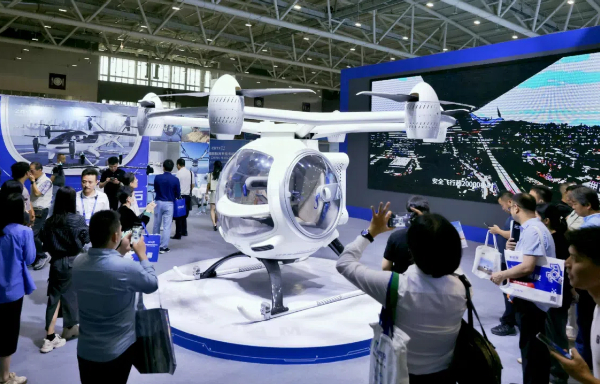Array of technologies debut at high-tech fair

A manned eVTOL (electric Vertical Take-off and Landing) aircraft makes its debut at the 26th High-Tech Fair in Shenzhen, drawing crowds of onlookers.[PARKER ZHENG/CHINA DAILY]
Robotics aimed at transforming everyday experiences, groundbreaking advancements in artificial intelligence and a deeper integration of education and industry were highlighted at the 26th China High-Tech Fair, which kicked off in Shenzhen, Guangdong province on Thursday.
More than 4,300 new technologies, products and achievements were released at the fair, which will last until Saturday.
The fair underscores a commitment to developing technologies that not only push the boundaries of innovation but also profoundly improve everyday life, according to Zhang Lin, director of the Shenzhen Science, Technology, and Innovation Bureau.
"Meanwhile, we want exhibitors in Shenzhen to see buyers from around the world and allow companies from around the globe to witness China's new quality productive forces," Zhang added.
Among the standout presences at the fair were an exhilarating array of technologies that could be used in robotics or prosthetics, such as high-performance flexible electronic skin and bionic dexterous hands.
The artificial skin, which can bend and stretch like real skin, can sense touch, pressure, temperature, and other external stimuli and convert these sensations into electrical signals. If used in robotics, this technology will make them more responsive and lifelike.
Various bionic dexterous hands — robotic hands designed to mimic the movements and capabilities of human hands — can now grasp, hold, and manipulate objects with great precision and flexibility, similar to how people use their own hands.
"The biggest change we've noticed this year is that people's attention has shifted more from four-legged robotic dogs to bipedal robots," said Lin Zhilong, the South China sales director of Hangzhou Yushu Technology, one of the earliest producers of quadruped robots in the world.
According to Lin, besides their latest robotic dog, the Unitree Go2, the company has also brought in its humanoid robot Unitree G1.
The Unitree G1, priced from 99,000 yuan ($13,699), features a 3D lidar system for 360-degree environmental awareness and showcased impressive stability by quickly adjusting its posture to remain upright and walk normally when pushed from behind.
In addition to robotic technologies, the fair has also spotlighted a deeper integration between education, scientific research, and industry in China, showcasing how the nation is fostering innovation across multiple sectors.
By presenting an impressive lineup of 69 groundbreaking technological achievements, Shenzhen University of Advanced Technology, the newest university inaugurated in the city this year, showed its latest advancements in key areas such as cell genetics, biomedicine, computing chips, and advanced energy materials, including a pioneering drug for organ failure and new PET imaging biomarkers for early detection of Parkinson's disease and autism.








